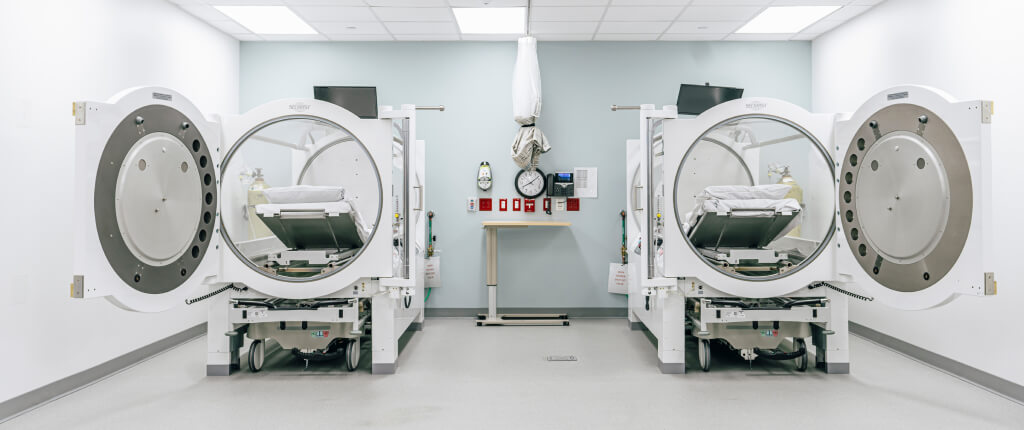Unlock the Power of Hyperbaric Oxygen Therapy for Faster Healing
Hyperbaric Oxygen Therapy (HBOT) has emerged as a pivotal approach in the realm of recovery, offering a special mechanism to boost recovery through raised oxygen levels. As various medical conditions profit from HBOT, comprehending its specific applications and the scientific research behind its effectiveness is crucial.
What Is Hyperbaric Oxygen Treatment?
Hyperbaric Oxygen Treatment (HBOT) is a medical therapy that involves using a pressurized chamber to provide pure oxygen to individuals. This treatment operates on the principle that enhancing ambient stress enables the lungs to soak up even more oxygen than under normal climatic conditions. hyperbaric oxygen therapy. As an outcome, the increased oxygen degrees in the bloodstream can substantially boost the body's natural recovery procedures
HBOT is administered in specialized chambers, which can suit one or more individuals and are usually readied to pressures varying from 1.5 to 3 times that of normal air. Throughout a session, clients breathe 100% oxygen while the stress is raised, leading to the dissolution of oxygen in physical fluids, consisting of plasma, lymph, and cerebrospinal fluid. This process not just enhances oxygen shipment to broken tissues however also promotes various biochemical responses vital for healing.
While HBOT is widely recognized for dealing with conditions such as decompression illness and carbon monoxide gas poisoning, it has actually also gained attention for its prospective applications in various other clinical fields. The therapy is normally well-tolerated, although it is necessary for individuals to be evaluated for any contraindications prior to therapy.
How HBOT Improves Healing
The increased oxygen degrees accomplished during Hyperbaric Oxygen Therapy (HBOT) play a considerable function in improving the body's recuperation processes. By delivering pure oxygen at raised pressures, HBOT promotes the diffusion of oxygen into tissues, advertising mobile metabolism and energy manufacturing. This increased oxygen schedule sustains the synthesis of adenosine triphosphate (ATP), the energy money of cells, which is essential for fixing and regrowth.
Additionally, HBOT stimulates angiogenesis, the formation of new members vessels, which is essential for providing nutrients and oxygen to damaged tissues. This procedure not only increases recovery yet also decreases the risk of chronic wounds and infections. Enhanced oxygenation additionally helps in the removal of toxins and inflammatory mediators, adding to a more reliable recuperation environment.

Benefits of Hyperbaric Oxygen Treatment
Patients going through Hyperbaric Oxygen Treatment (HBOT) frequently experience an array of benefits that extend past enhanced recovery times. One of the main benefits of HBOT is its capability to improve oxygen delivery to cells. By enhancing oxygen focus in the blood, HBOT promotes mobile metabolic process and encourages the repair of damaged cells.
Additionally, HBOT has been shown to decrease swelling, which can alleviate pain and improve total recovery. This anti-inflammatory effect can be particularly advantageous for patients recovering from surgical procedure, injuries, or persistent conditions. Additionally, the try this treatment stimulates the development of new members vessels, a procedure understood as angiogenesis, which is important for supplying nutrients to healing tissues.
Another significant benefit is the possibility for enhanced immune function. By boosting the body's oxygen levels, HBOT can reinforce immune actions, aiding patients ward off infections throughout healing. Lots of patients report increased energy levels and minimized tiredness following treatment, contributing to an overall feeling of health.
Problems Treated With HBOT
Numerous clinical problems can take advantage of Hyperbaric Oxygen Therapy (HBOT), making it a functional therapy option in different healthcare settings. HBOT is mostly identified for its efficiency in dealing with decompression sickness, a problem frequently experienced by divers. Additionally, it plays an important function in promoting the recovery of persistent injuries, particularly diabetic foot abscess, by boosting oxygen delivery to compromised tissues.
Various other problems that might be treated with HBOT consist of radiation injuries, where it assists in tissue healing after radiation treatment. It is also helpful for carbon Go Here monoxide poisoning, as it aids displace carbon monoxide from hemoglobin, recovering typical oxygen levels in the blood. HBOT is utilized in instances of thermal burns, enhancing the healing process and lowering the danger of infection.
Clients suffering from osteomyelitis, an infection of the bone, may also experience enhanced end results via HBOT, as it assists to enhance oxygen supply to contaminated cells. Particular neurological problems, such as traumatic brain injury and stroke, are being discovered for HBOT's possible neuroprotective effects - hyperbaric oxygen therapy. Generally, the varied applications of HBOT emphasize its value in modern-day medicine
What to Anticipate During Therapy
Following the expedition of numerous problems treated with Hyperbaric Oxygen Treatment (HBOT), understanding what to expect throughout treatment is essential for patients considering this treatment. The treatment generally happens in a specialized chamber, which can fit one or numerous people. Throughout the session, the chamber is progressively pressurized, allowing the individual to take a breath in pure oxygen at degrees higher than climatic pressure.
People can expect to undertake several sessions, each lasting about 60 to 90 mins. There may be a sensation of fullness in the ears, comparable to what one experiences throughout altitude adjustments, but this usually resolves promptly with easy equalization methods.
The therapeutic atmosphere is checked by experienced experts that guarantee security and convenience. Patients are encouraged to loosen up, as they might read or listen to songs click during the treatment. While many individuals tolerate HBOT well, some might experience moderate negative effects such as tiredness or momentary visual changes.
Eventually, recognizing these aspects can help minimize any kind of anxieties and prepare people for a useful healing experience with HBOT.
Final Thought
